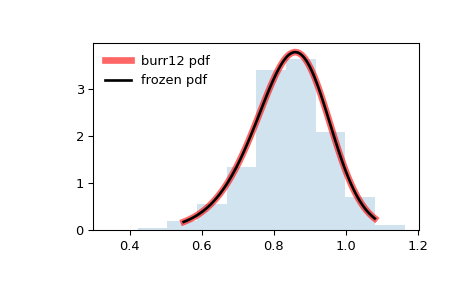scipy.stats.burr12¶
-
scipy.stats.burr12(*args, **kwds) = <scipy.stats._continuous_distns.burr12_gen object>[source]¶ A Burr (Type XII) continuous random variable.
As an instance of the
rv_continuousclass,burr12object inherits from it a collection of generic methods (see below for the full list), and completes them with details specific for this particular distribution.Notes
The probability density function for
burris:\[f(x, c, d) = c d x^{c-1} / (1 + x^c)^{d + 1}\]for \(x >= 0\) and \(c, d > 0\).
burr12takescanddas shape parameters for \(c\) and \(d\).This is the PDF corresponding to the twelfth CDF given in Burr’s list; specifically, it is equation (20) in Burr’s paper [1].
The probability density above is defined in the “standardized” form. To shift and/or scale the distribution use the
locandscaleparameters. Specifically,burr12.pdf(x, c, d, loc, scale)is identically equivalent toburr12.pdf(y, c, d) / scalewithy = (x - loc) / scale. Note that shifting the location of a distribution does not make it a “noncentral” distribution; noncentral generalizations of some distributions are available in separate classes.The Burr type 12 distribution is also sometimes referred to as the Singh-Maddala distribution from NIST [2].
References
- 1
Burr, I. W. “Cumulative frequency functions”, Annals of Mathematical Statistics, 13(2), pp 215-232 (1942).
- 2
https://www.itl.nist.gov/div898/software/dataplot/refman2/auxillar/b12pdf.htm
- 3
“Burr distribution”, https://en.wikipedia.org/wiki/Burr_distribution
Examples
>>> from scipy.stats import burr12 >>> import matplotlib.pyplot as plt >>> fig, ax = plt.subplots(1, 1)
Calculate a few first moments:
>>> c, d = 10, 4 >>> mean, var, skew, kurt = burr12.stats(c, d, moments='mvsk')
Display the probability density function (
pdf):>>> x = np.linspace(burr12.ppf(0.01, c, d), ... burr12.ppf(0.99, c, d), 100) >>> ax.plot(x, burr12.pdf(x, c, d), ... 'r-', lw=5, alpha=0.6, label='burr12 pdf')
Alternatively, the distribution object can be called (as a function) to fix the shape, location and scale parameters. This returns a “frozen” RV object holding the given parameters fixed.
Freeze the distribution and display the frozen
pdf:>>> rv = burr12(c, d) >>> ax.plot(x, rv.pdf(x), 'k-', lw=2, label='frozen pdf')
Check accuracy of
cdfandppf:>>> vals = burr12.ppf([0.001, 0.5, 0.999], c, d) >>> np.allclose([0.001, 0.5, 0.999], burr12.cdf(vals, c, d)) True
Generate random numbers:
>>> r = burr12.rvs(c, d, size=1000)
And compare the histogram:
>>> ax.hist(r, density=True, histtype='stepfilled', alpha=0.2) >>> ax.legend(loc='best', frameon=False) >>> plt.show()

Methods
rvs(c, d, loc=0, scale=1, size=1, random_state=None)
Random variates.
pdf(x, c, d, loc=0, scale=1)
Probability density function.
logpdf(x, c, d, loc=0, scale=1)
Log of the probability density function.
cdf(x, c, d, loc=0, scale=1)
Cumulative distribution function.
logcdf(x, c, d, loc=0, scale=1)
Log of the cumulative distribution function.
sf(x, c, d, loc=0, scale=1)
Survival function (also defined as
1 - cdf, but sf is sometimes more accurate).logsf(x, c, d, loc=0, scale=1)
Log of the survival function.
ppf(q, c, d, loc=0, scale=1)
Percent point function (inverse of
cdf— percentiles).isf(q, c, d, loc=0, scale=1)
Inverse survival function (inverse of
sf).moment(n, c, d, loc=0, scale=1)
Non-central moment of order n
stats(c, d, loc=0, scale=1, moments=’mv’)
Mean(‘m’), variance(‘v’), skew(‘s’), and/or kurtosis(‘k’).
entropy(c, d, loc=0, scale=1)
(Differential) entropy of the RV.
fit(data)
Parameter estimates for generic data. See scipy.stats.rv_continuous.fit for detailed documentation of the keyword arguments.
expect(func, args=(c, d), loc=0, scale=1, lb=None, ub=None, conditional=False, **kwds)
Expected value of a function (of one argument) with respect to the distribution.
median(c, d, loc=0, scale=1)
Median of the distribution.
mean(c, d, loc=0, scale=1)
Mean of the distribution.
var(c, d, loc=0, scale=1)
Variance of the distribution.
std(c, d, loc=0, scale=1)
Standard deviation of the distribution.
interval(alpha, c, d, loc=0, scale=1)
Endpoints of the range that contains alpha percent of the distribution
